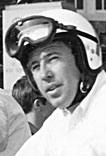 Bill France Jr. headed NASCAR for nearly 30 years, starting in the early 1970s, and guided that association during its period of explosive growth into the most popular form of motorsports in America. Over the years, he did about everything possible in the racing business, from selling concessions and parking cars at the old beach/road course in Daytona Beach, Florida, to fashioning complicated mergers with captains of industry. He spent more than a year of his life working 12-hour days, seven days a week, to build Daytona International Speedway.
Bill France Jr. headed NASCAR for nearly 30 years, starting in the early 1970s, and guided that association during its period of explosive growth into the most popular form of motorsports in America. Over the years, he did about everything possible in the racing business, from selling concessions and parking cars at the old beach/road course in Daytona Beach, Florida, to fashioning complicated mergers with captains of industry. He spent more than a year of his life working 12-hour days, seven days a week, to build Daytona International Speedway.
France also continued his father’s legacy of fostering the growth of America’s premier motorcycle race, the Daytona 200. In addition, he brought innovative new ideas, such as the introduction of supercross racing to the Speedway, which helped Bike Week grow to the point of attracting 500,000 motorcyclists to Daytona Beach each March.
France was born in Washington, D.C., in 1933, but his family moved to Daytona Beach when he was just a toddler. Young France began working in the family’s burgeoning racing business as a boy. His early jobs included helping in the concession stands and he later advanced to parking cars. Parking cars on the beach could be a major challenge, as France remembers in one humorous incident.
"When the tide started coming in after the race, some of the cars would be caught by the water. I was riding around in a truck with a public address system telling everybody to keep moving. You can drive in the water because it doesn't drown a car and you won't get stuck. If you stop, by the second wave you're stuck for good. I'm out in the ocean with this truck telling people to keep moving. I had waves crashing over that old truck I was riding in, but it kept running."
France loved motorcycles and starting riding at a young age.
"I had a little Harley 125 that I loved to ride on the beach," France remembers. "Jim Davis, the great old racer, taught me how to ride when I was pretty young. You couldn’t have gotten lessons from a better person."
In an interview, Davis recalled teaching France to ride.
"I asked him if he knew how to ride a bicycle. He said 'Yes,' so I told him it was just like riding a bike except you didn’t have to pedal."
When construction began on Daytona International Speedway, France Jr. worked tirelessly to complete the mammoth project.
"I ran a motor grader some and a bulldozer, but mostly I was on a compactor," he remembers. "I did a little of this, that and the other. I even had a mule out there one time pulling trees out of the swamp. Everything that was motorized back then got stuck in the swamp. I said, let's try a mule. That didn't work either.
"We'd have big piles of stumps that we had to burn. I remember seeing a big rattlesnake out here one day. They asked me, 'Where did you find him at?' I pointed to where I found it. This one man had an ax and he swung it into a stump and we heard rattles buzzing all over the place. The area was full of snakes. We cleared out of there pretty fast.
"We went seven days a week for 13 months to build the Speedway. We went from 7 in the morning to 7 at night, and worked in the winter until it got dark."
In the 1960s, France, like thousands of motorcyclists of the era, got caught up in the off-road revolution. He started riding off road and competed in enduros. In the early 1970s, France entered the motorcycle division in the legendary Baja 1000.
"My co-rider had a high-speed crash so I didn’t do much," France says. "The bike was all bent up so I just tried to nurse it home to the finish."
His interest in off-road motorcycling led to his idea of bringing in the up-and-coming sport of motocross as part of the Daytona racing program in the early 1970s. The motocross races started with little fanfare, but grew into the popular Daytona Supercross.
"I thought motocross was going to be a big thing," France remembers. "At first, we ran the race by the lake in the back section of the Speedway. My dad was the one who suggested we move the race up in front of the grandstands. After that it really took off and started attracting big crowds."
France is quick to credit his younger brother, Jim, as one of the driving forces behind the emergence of AMA Superbike racing.
"We saw that the old 750 class (Formula One) was dominated by one brand and the factory bikes had too much of an advantage. Jim wanted to give all the riders a better chance and he saw the superbikes as a way to do that. I think it worked out pretty well."
France deserves much of the credit for helping make Daytona the biggest week of motorcycling in America. His decision to include motocross in Speedway racing activities proved to be one of great foresight.
France passed on the legacy of his famous father to his son, Brian, who was named CEO of NASCAR in 2003. Bill Jr. remained active in guiding the family’s racing business even after his retirement. He was inducted into the AMA Motorcycle Hall of Fame in 2000.